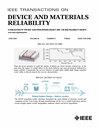Irradiation-Induced Degradation of Surface Acoustic Wave Devices Fabricated on Bulk AlN
IF 2.5
3区 工程技术
Q2 ENGINEERING, ELECTRICAL & ELECTRONIC
IEEE Transactions on Device and Materials Reliability
Pub Date : 2022-10-11
DOI:10.1109/TDMR.2022.3212050
引用次数: 2
Abstract
Here, recent work to evaluate the prospects for surface acoustic wave (SAW) devices fabricated on bulk aluminum nitride (AlN) for elevated temperature and radiation environments is reported and discussed. The design and fabrication of an array of SAW devices using commercial wafers is described, including the non-standard fabrication approach taken to overcome the stress-induced warpage of the 50 mm diameter AlN substrates. Radio frequency performance characterization of the SAW devices, with resonance frequencies ranging from 0.5 GHz to 1.5 GHz, is described. The linear temperature coefficient of frequency (TCF) near room temperature was measured and is compared to theoretical results from other investigators. The effects of 8 MeV Al ion irradiation at 300°C and 500°C to damage levels of 0.01, 0.1 and 1 displacements per atom (dpa), as a proxy for neutron irradiation, was investigated. The ion irradiation damage was observed to decrease the SAW resonant frequency, and this effect is characterized and discussed. Significant degradation in the conductivity of the Ti/Al electrodes of the SAW devices was also observed and characterized. These experimental results provide a basis for further investigation of the prospects for development of SAW sensor devices in bulk AlN material for application in elevated temperature and radiation environments.块状氮化铝表面声波器件的辐照诱导降解
本文报道和讨论了近年来在高温和辐射环境下用大块氮化铝(AlN)制造的表面声波(SAW)器件的前景。描述了使用商用晶圆设计和制造一系列SAW器件,包括采用非标准制造方法来克服直径为50mm的AlN基板的应力引起的翘曲。描述了谐振频率范围为0.5 GHz至1.5 GHz的SAW器件的射频性能特征。在室温附近测量了线性频率温度系数(TCF),并与其他研究者的理论结果进行了比较。研究了8mev Al离子在300°C和500°C下辐照对原子损伤水平为0.01、0.1和1位移/原子(dpa)的影响。离子辐照损伤会降低SAW的共振频率,并对这种效应进行了表征和讨论。还观察和表征了SAW器件的Ti/Al电极的电导率的显著下降。这些实验结果为进一步研究在高温和辐射环境中应用的大块AlN材料SAW传感器器件的发展前景提供了基础。
本文章由计算机程序翻译,如有差异,请以英文原文为准。
求助全文
约1分钟内获得全文
求助全文
来源期刊

IEEE Transactions on Device and Materials Reliability
工程技术-工程:电子与电气
CiteScore
4.80
自引率
5.00%
发文量
71
审稿时长
6-12 weeks
期刊介绍:
The scope of the publication includes, but is not limited to Reliability of: Devices, Materials, Processes, Interfaces, Integrated Microsystems (including MEMS & Sensors), Transistors, Technology (CMOS, BiCMOS, etc.), Integrated Circuits (IC, SSI, MSI, LSI, ULSI, ELSI, etc.), Thin Film Transistor Applications. The measurement and understanding of the reliability of such entities at each phase, from the concept stage through research and development and into manufacturing scale-up, provides the overall database on the reliability of the devices, materials, processes, package and other necessities for the successful introduction of a product to market. This reliability database is the foundation for a quality product, which meets customer expectation. A product so developed has high reliability. High quality will be achieved because product weaknesses will have been found (root cause analysis) and designed out of the final product. This process of ever increasing reliability and quality will result in a superior product. In the end, reliability and quality are not one thing; but in a sense everything, which can be or has to be done to guarantee that the product successfully performs in the field under customer conditions. Our goal is to capture these advances. An additional objective is to focus cross fertilized communication in the state of the art of reliability of electronic materials and devices and provide fundamental understanding of basic phenomena that affect reliability. In addition, the publication is a forum for interdisciplinary studies on reliability. An overall goal is to provide leading edge/state of the art information, which is critically relevant to the creation of reliable products.
 求助内容:
求助内容: 应助结果提醒方式:
应助结果提醒方式:


